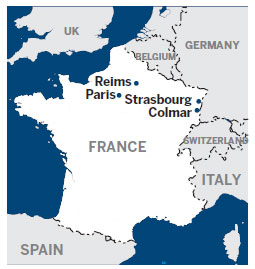
Like many other winery owners, Lorentz-Klipfel started making connections with China two years ago and sold 80,000 bottles to the country in 2011.
"I've been to China three times over the past two years, and have just come back from a three-week trip to 10 Chinese cities in June," he says.
From Colmar, we head to Reims, about 300 km away. It's the capital of the Champagne region. I regret to say that, like many others, I previously used to call all sparkling wines Champagne.
"Actually, only those produced from grapes grown in the Champagne region and made in line with strictly regulated processes can be labeled Champagne," confirms Philippe Wibrotte, public relations manager of the Champagne Wine Association.
Every year, the association deals with brand-name infringements.
"We have more than 1,000 cases pending settlement, and there are 30-60 new cases arising every year," he says.
In France, if you think wine cellars merely serve as storage for bottles of wine, you are wrong. It is also a window of exploration for history, culture and art.
Champagne Pommery, a Champagne producer in Epernay, a small town near Reims, has wine cellars that are like entering an art gallery.
The arched cellars, 18 km in length and 30 meters underground, store about 20 million bottles of champagne, with the oldest dating back to 1874. But what fascinates ordinary visitors most are the ancient chalk pits and the artworks showcased inside.
About 300 ancient caves in the Reims region were once Roman quarries, dug in the 4th century. They had been abandoned until the 18th century, when the champagne industry flourished and wine cellars were dug for storing champagne.
Pommery House owns 120 of the caves, which have been fitted out and extended.

It is stunning to find exquisite bas-relief sculptures inside a wine cellar. Carved out of the limestone on the cave walls, four of these were created by Gustav Navlet in 1884, who spent four years working on the sculptures in the dim light.
The beautifully preserved bas-relief structures are today juxtaposed against contemporary art exhibitions of world-renowned artists.
Hautvillers, a small village on the outskirts of Epernay, is another elegant destination in the Champagne region.
What catches visitors' eyes most are the more than 140 wrought-iron signs hung on the front-facing walls of residential homes, vividly indicating the family business. It is a tradition inherited from the old days, when a significant number of villagers couldn't read.
As a fine vine-growing village in the Champagne region, Hautvillers has narrow streets and centuries-old houses. An old-fashioned lavoir, a public place to wash clothes, was built in 1832 and is still in use today. The village abbey, first constructed in AD 650 has been destroyed and renovated several times, but is now standing proud.
Hautvillers is best known around the world for Dom Perignon (1638-1715), a monk and cellar master, who resided at the Benedictine Abbey in Hautvillers for 40 years - and was buried here after his death. He was the first to blend various wines during the second fermentation and turned plain still wine into sparkling wine.
Strolling around peaceful and quiet French villages like Hautvillers, one gets used to a slower-paced life, and it is easy to imagine what life was like in the old days.
On an old wall are written some lines for the villagers' morning prayer. Instead of being profound and religious, the words are simple and down-to-earth, providing a perfect understanding of life as it should be lived:
"Give me a healthy body for a long time,
Give me jobs sometimes,
Give me love from time to time,
But give me Champagne all the time."
Contact the writer at maoning@chinadaily.com.cn.